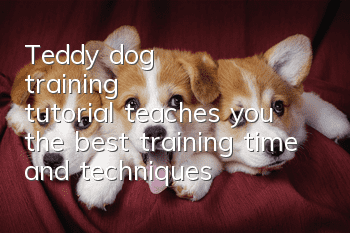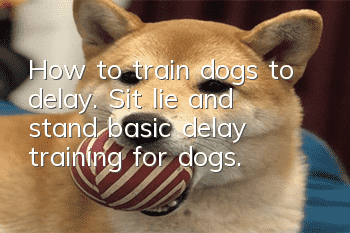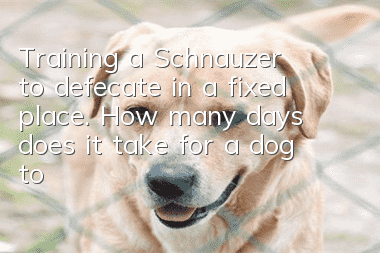Teddy dog training tutorial teaches you the best training time and techniques

Basic tips for training Teddy dogs
1. The dog’s conditioned reflex should be cultivated and should be carried out in a quiet place with little external interference.
2. The dog’s conditioned reflex should be gradually complicated, that is, to strengthen the dog’s ability to continuously adapt to new environments.
3. In a complex environment, the dog can still execute the command whenever a tempting stimulus signal appears.
4. In order for the dog to successfully master the skills taught, dog trainers should use certain methods and means to reward diligence and punish laziness, and cultivate the dog's initiative, so that the trained dog can truly become successful.
The best time to train Teddy dogs
When the dog reaches 3 to 4 months old, you can start training it with some simple things. Such as sniffing with the nose and holding things with the mouth. The raising and training of a dog before it is one year old determines the dog's future. Therefore, dog education and training should start as early as possible. Education and learning to develop various good habits are prerequisites for future training.
Dogs are fast-growing animals. Generally speaking, dogs that are a few months old can help humans work. But don’t let the dog do too difficult work too early, and don’t test the dog’s skills, ferocity, and desire to fight too early. This will make the dog develop bad habits of disobedience and crazy biting. When a dog is about 15 months old, it is time to train it in stages to become ferocious and enhance its desire to fight.
Basic methods of Teddy dog training
1. Food stimulation method
It is a method of stimulating the trained dog with food to make it complete the prescribed actions. Food stimulation method can be used as a means of induction, because food can stimulate the dog's nervous system and stimulate the dog's appetite, especially the food it likes. This method can effectively make the trained dog actively participate in the training and quickly complete the training subjects.
Food stimulation method can also be used as a means of encouragement. When the trained dog has completed the specified action well, in order to consolidate the conditioned reflex, it can be given its favorite food as a reward. Food stimulation can also be used as a means of relief. When the trained dog completes the prescribed actions under strong mechanical stimulation, in order to relieve the trained dog's nerves and strengthen its dependence on people, some food can be fed.
Since the food stimulation method is active and the trained dog is willing to accept it, the dog's actions are naturally active and the nerves are in an excited state. However, this method also has its own limitations, that is, it cannot completely guarantee that the dog will follow human instructions. If used improperly, it can lead to food dependence in dogs, which requires food for guidance.
2. Mechanical stimulation method
The mechanical stimulation method is a method that uses machinery, such as leather ropes and dog leashes, to force the trained dog to make a certain response. This method can be used as a means of coercion. For example, leading a dogWhen going out, some dogs like to run across and fast in front of their owners, while other dogs look around and jump behind their owners. In order to control these two types of dogs, the owner or dog trainer must put a leash or rope on the dog. , control it by its side so that it can neither get ahead nor fall behind.
Mechanical stimulation can also be used as a means of prohibition. If you want to stop the dog from doing something or not doing something, while issuing the stop command, use coercive means to cooperate. This method is most effective and timely when dogs are trained to bite passers-by, pick up food, or hunt poultry. The mechanical stimulation method can also take certain punitive measures against the dog. If the trained dog repeatedly makes mistakes, severe reprimands are ineffective, and the owner's authority is ignored, mechanical stimulation should be used for education. This method is often very effective in correcting the problems of adult dogs.
Since the mechanical stimulation method is an external, simple, and relatively rigid method, appropriate intensity should be paid attention to when using it. We should treat dogs according to their characteristics, especially puppies. If the stimulation is too strong, it will inhibit the dog's excited nerves, affect the training effect, and easily affect the dog's dependence on people. Therefore, in order to relieve the dog's nervous state and consolidate the conditioned reflex, this method is often used in conjunction with rewards and other means.
3. Imitation training method
It is a training method that uses the behavior of well-trained and well-educated dogs to influence or drive the trained dogs. This method is often used on dogs when they are not yet adults, because they are in the transitional stage of growth and development and are most susceptible to the influence of their "people". The behavior of other dogs often becomes the target of their active imitation. Of course, the selection of adult dogs must be excellent dogs that can occupy a dominant position and set an example, otherwise this method will be difficult to be effective.
4. Combined use of rewards and punishments
The combined use of rewards and punishments is a method that combines mechanical stimulation with food stimulation, stroking and verbal praise that are similar in nature to food stimulation. The popular saying is "slap once and rub three times". This method not only allows dogs to know what not to do, but also what they should do, with clear rewards and punishments, and the best results.
Basic points of training
1. Persistence in training every day
The most important thing for training Teddy dogs is to be persistent. You don’t need to schedule too much time every day, but don’t rush. Go step by step without getting impatient. If the owner can't muster up the energy to train the dog first, the dog will be sensitive to your emotions. It also becomes lazy. If this training is arranged for too long, the dog will also feel bored, lose the sense of freshness, and will not be too focused on learning.
2. Praise more and reprimand less
When Teddy Dog Training completes a certain action according to the owner's order and is praised by you, it will show joy and satisfaction beyond our imagination. So we should praise and encourage it more and regard it asBasic principles of training and education. Too much scolding can make a dog dull. If you treat it according to the ratio of one rebuke to nine praises and give it more praise and encouragement, it will show more and more intense learning enthusiasm.
3. Even if you reprimand, praise on the spot
When a dog does something it shouldn’t do, it must be reprimanded a few times in time. If you reprimand after this period, it will not remember that it is Being criticized for something. The same is true when rewarding it. If it passes this time, the purpose of praise may not be achieved.
4. Coordinate sound and gestures
When the dog does something it shouldn’t do, reprimand it: “No”; and when it follows the owner’s orders, praise it. It said: "Awesome". These basic passwords should be short, easy to distinguish, and consistent once chosen. Correspondingly, gestures are used to clearly show the owner's attitude.
5. The training attitude should be unified
If the dog is raised in the family, all family members should reach the same understanding and adopt a unified approach to its education and training. Of course, it is best to designate one person at home who is mainly responsible for training it; but the whole family must uniformly control under what circumstances reprimand it and when to praise it. If someone has an ambiguous attitude towards something it does, but someone else reprimands it, it will be confused and cannot figure out whether it is right or wrong, whether it should be done or not.
- Reasons why dogs eat grass. Dogs bite weeds because they eat too few vegetables.
- Things to note when raising a dog: Six things you need to do when raising a pet dog
- How to make a dog obedient? Three easy tips to teach you how to train a well-behaved dog
- Common skin diseases in dogs Five common skin diseases in dogs and their treatments
- Daily training methods for dogs Six small contents of daily training for dogs
- How to make your dog more docile Five ways to make your dog more docile
- The Secret to Longevity for Dogs: Pay attention to four aspects to extend your dog’s life
- Does Labrador drool a lot? Why does Labrador drool a lot?
- What are the types of dog vaccines? An introduction to three types of vaccines commonly used in pet clinics
- How to raise a Bichon Frize? 3 common misunderstandings in the daily feeding of Bichon Frize



